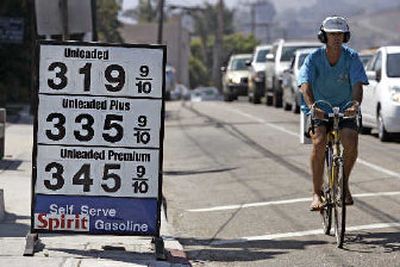Will energy-sector stock gains last?

NEW YORK — Sometimes logic doesn’t rule on Wall Street. Investors might want to keep that in mind before they see a ripe buying opportunity in energy-sector stocks as Hurricane Katrina sends prices soaring.
While big money has been pouring into shares of oil and natural gas producers, refiners and retailers, like Exxon Mobil Corp. and Valero Energy Corp., since the storm hit, whether those stocks remain attractive much longer is hardly a sure thing.
That’s because there is still so much uncertainty about how the aftermath of the hurricane will play out and what it will mean for supply and demand.
Of course, there are plenty of people on Wall Street who argue that it’s a good time to dip into the sector. Some major investment firms have raised their ratings to “buy” on oil-sector stocks, especially refiners, because of the post-hurricane profit potential.
And it is easy to see why these shares have been so attractive to the investing public in recent years. The gains in their earnings have far outpaced most everything else out there.
Even before Katrina hit last week, oil prices had risen 50 percent in the last year largely because inventories were stretched by growing global demand. Then Katrina knocked out eight U.S. refineries for a time, which economists deem to be a “supply shock.” In addition, more than half of normal offshore Gulf of Mexico oil production still is shut down.
That massive cutback managed to thrust crude oil prices over $70 a barrel last week, though that rise has eased up a bit to now trade around $65 a barrel. Still, gas prices at the pump remain above $3 a gallon in many parts of the country and natural gas and home heating oil prices are up significantly.
As a result, energy stocks in the Standard & Poor’s 500 index are up more than 6 percent since the hurricane first hit, boosting their year-to-date gains to 34 percent. And that comes on top of a 29 percent rise in 2004. Shares of utilities in the S&P 500 have climbed nearly 4 percent post-Katrina and are up almost 19 percent for the year after a 20 percent rise in 2004.
The biggest winners of the last two weeks were refiners, which saw their shares climb 20 percent in the days after the hurricane, led by double-digit gains at companies including Valero, Giant Industries Inc. and Sunoco Inc.
But recent research from Bear Stearns equity derivatives strategist Marko Kolanovic offers a note of caution. He found that historically after big storms pass and the damage is assessed, oil prices and energy stocks no longer work in lockstep.
He looked back at 13 major hurricanes over the last 20 years and studied the correlation between movements in the American Stock Exchange Energy Select Sector Index and the price of crude oil for three months after a hurricane.
Within about two to five weeks after the onset of the storm, the correlation deviates. Crude prices continued to climb largely due to a supply shock while energy stocks remained stuck in a trading range because of concerns about disruptions to energy-related facilities and pipelines.
Kolanovic isn’t the only one on Wall Street waving a caution flag. Tobias Levkovich, chief U.S. equity strategist at Citigroup’s Smith Barney division, forecasts that oil prices will likely stay higher in the months ahead as companies assess the damage to their operations. But he isn’t necessarily convinced that energy-related stocks will follow suit. “We don’t know the extent of the damage to the refineries under water … to the pipelines,” he said. “It is hard to know when the run you have had in oil prices will back off.”